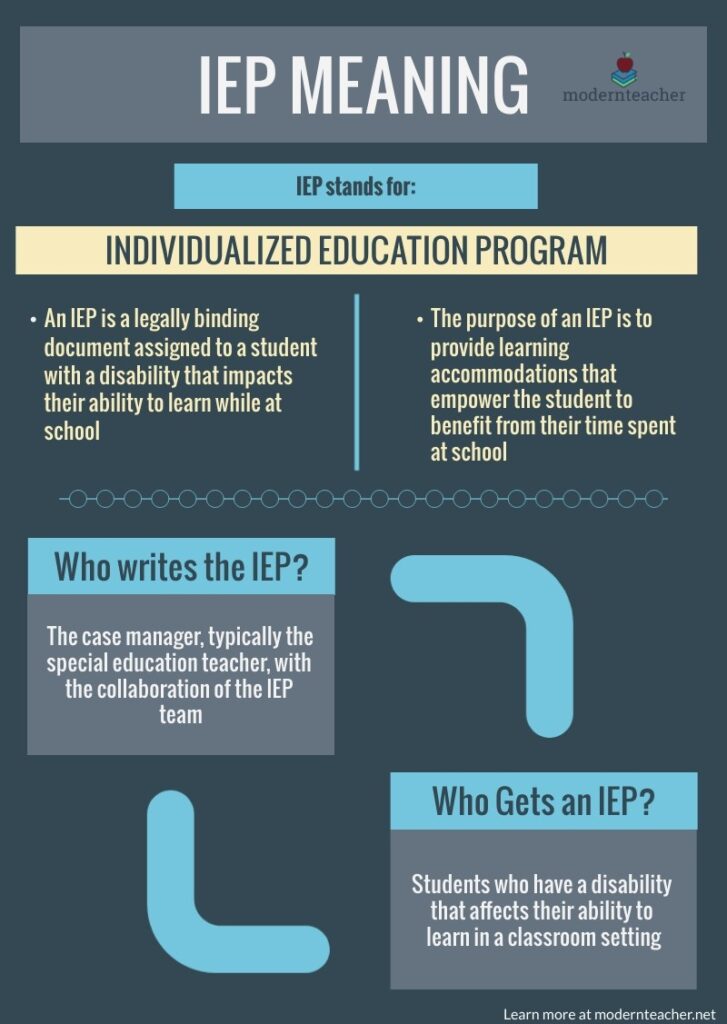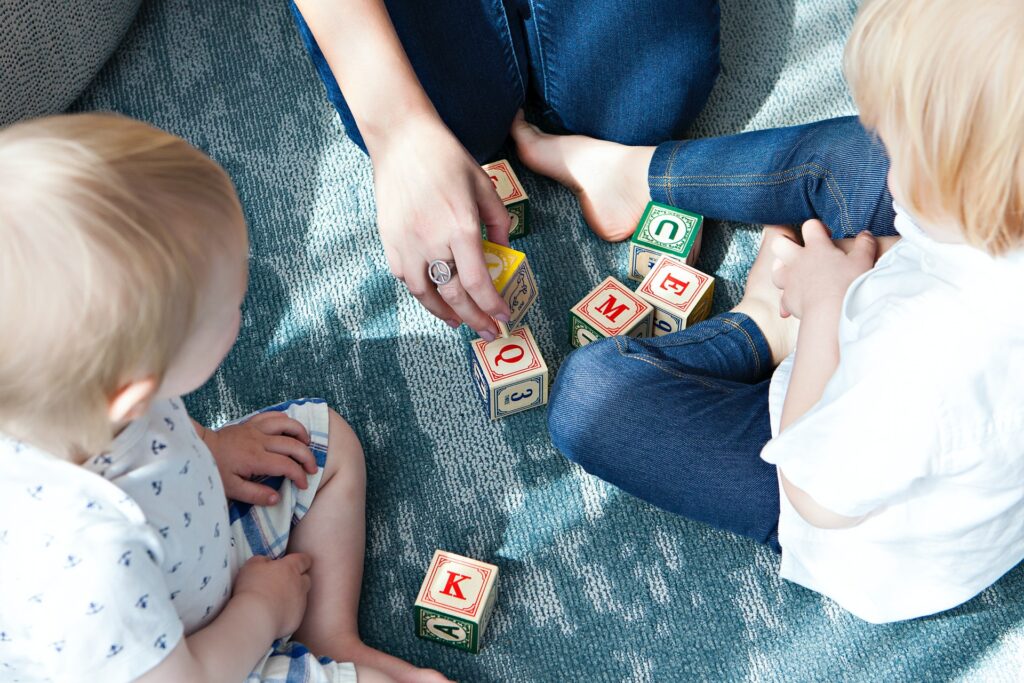IEP Meaning
IEP stands for Individualized Education Program. The IEP is a document that contains many sections of information related to the student, their abilities, and their needs, which you can find outlined in this article Writing an IEP. The central parts of the IEP are the annual, measurable goals (which you can read more about here), and the supplementary aids and services that will be provided by the school district at no cost to the student or family. These aids and services can range from simply providing pictures and visual supports during lessons to receiving weekly occupational therapy sessions.
IEP Meaning Infographic:

What is an IEP?
In the American education system, students who qualify for special education have what’s called an IEP implemented at their school. The purpose of an IEP is to provide the accommodations, modifications, and supplementary aids and services necessary to ensure that the student receives a free and appropriate public education, and that their educational program meets that student’s unique needs. This article dives into the meaning of an IEP and explains the context in which schools utilize IEPs.
IEP Meaning: Who Should Have an IEP?
According to the National Center for Education Statistics, 14.4% of students aged 3 to 21 years old during 2019-2020 received special education services under the direction of the Individuals with Disabilities Education Act (IDEA). Students who qualify for special education services receive an IEP. This is the criteria one must meet in order to qualify.
- Have one or more of the eligible disabilities
- Your disability negatively impacts how you perform in school
To learn more about the eligibility disabilities, click here.

Students who qualify for special education must go through a process of evaluation before their IEP can be developed. According to section 1414 of IDEA, this usually includes an initial evaluation where the local educational agency must:
- Use a variety of assessment tools and strategies to gather information (the district cannot use only one assessment to determine whether or not the child has a disability or in determining an appropriate education program)
- Use technically sound instruments that may assess the relative contribution of cognitive and behavioral factors, in addition to physical or developmental factors
- Gather relevant functional, developmental, and academic information (including information provided by the parent)
- Information gathered should be enable the child to access and progress through general education curriculum
The information gathered will assist in determining whether the child has a qualifying disability and the content of the child’s IEP. The parent must receive a copy of the evaluation report and the documentation of determination of eligibility. If they determine that the student qualifies for special education, the school will create an IEP. The IEP meeting must be held within 30 days after it is determined that a student qualifies for special education.
IEP team members:
- Student
- Case Manager (Special Education Teacher/Education Specialist)
- Parents/guardians
- General Education Teacher
- Administrator
- Related Service Providers (i.e. speech and language pathologist, physical therapist, etc.)
- School Psychologist (this member only needs to be present for eligibility evaluations).
- Anyone else involved in the child’s education
Typically, the special education teacher collaborates with all of the different stakeholders while drafting the IEP. The IEP team reviews the draft at the IEP meeting. If all members of the IEP team consent to the contents of the IEP, they sign. Once the IEP is signed, it’s a legally-binding document.

The Three Main Types of IEP Meetings:
- Initial Evaluation
- Plan Review (Annual)
- Eligibility Evaluation (Triennial)
The initial evaluation IEP meeting is the first IEP meeting a student has. This is where you discuss the student’s eligibility where you draft their first IEP. Moving forward, there will be an annual IEP meeting in order to review their plan, create new annual goals, and update services as needed. Every three years, there will be an eligibility evaluation IEP meeting where the district will determine whether or not the student is still eligible for special education. To read more about the differences between an annual plan review IEP meeting and a triennial eligibility evaluation IEP meeting, click here (coming soon).
IEP Meaning: Significance of an IEP
IEPs are essential educational plans for students with disabilities to have in the public education system. This plan ensures that regardless of their disability, the student will receive a free and appropriate education.
This plan will include details of the student’s performance, special factors (such as their need for assistive technology), annual goals to measure their progress in their areas of deficit, related services (i.e. specialized academic instruction, psychologist services, speech and language), and the student’s individualized educational setting. Outlined in the educational setting is the amount of time the student will spend inside the general education setting (typical classroom), and outside the general education setting (special education classroom or services).
Being aware of every element in your IEP or your child’s IEP is super important. As a parent, you’re entitled to everything documented in the plan. If your district fails to provide a service noted on the IEP, you have every right to call an IEP meeting. Feel free to contact us if you have any questions related to IEPs!
IEP FAQs:
IEP stands for Individualized Education Program, which is a document that outlines a student’s present levels, goals, and services when they qualify for special education.
The IEP is a collaborative plan that is typically drafted by the student’s case manager, normally the special education teacher, along with input from other IEP team members (i.e. parents, related-service providers, administrators).
Any student who meets one of the thirteen disability categories, and whose educational progress is impacted by their disability, is eligible for an IEP.
Both plans provide students with disabilities accommodations in school, but only IEPs provide a specialized instruction program that is updated yearly and extends beyond accommodations to include related-services, annual goals, and other sections/supports.
IEPs are beneficial because they ensure a student with a disability receives a free and appropriate public education (FAPE) through written, and legally-binding, related-services with required minutes (i.e. speech and language, occupational therapy), annual and measurable goals targeting deficits, and special factors including behavior supports and assistive technology as needed. Additionally, IEPs contain a description of the student’s present levels of performance in a variety of domains derived from appropriate assessments and observations, which can inform teachers on best strategies and methods to use when teaching the student.
The main purpose of an IEP is to provide students with a disability a Free and Appropriate Public Education (FAPE) through a written plan that implements goals, services, and other supports.
All parts of the IEP are important, however the most important part could be the annual goals since they are meant to target the student’s deficits and measure their progress and performance throughout the year in these areas of need. Other important parts would be the student’s present levels of performance, special factors (for students with behavioral needs or who require assistive technology), and related services and supplemental aids and supports.

